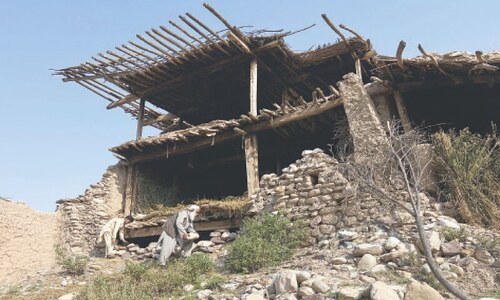
PESHAWAR: The popular dotted chaddar ‘Chail’ worn by women in Swabi district is still considered an emblem of respect and esteem as it fully covers the body.
According to the residents, there used to be Dhobiyan (artisans) around almost every village who would make with hands the ‘Chail’, a kind of shawl for women. Then an incident took place, which changed the history of the handmade shawl of Swabi.
Anwar Khan, a young artist who has recently submitted a thesis on Swabi ‘Chail’ to the Fine Arts and Design Department, University of Peshawar, told this scribe that the famous Swabi shawl highlighted a famous Pashtun legend through its colour and dot patterns. He said the red dot shawl was the most significant, which was associated with a historical fact.
It is considered as symbol of modesty and resistance
Safia Gul, a woman from Shamansoor village, said that women preferred to use ‘Chail’ as a proud symbol of Yousafzai’s bravery. She said being a traditional headgear it was still intact in the area and women used it on all occasions. “Chail is our pride and identity. I don’t know about its meaning, but I do know about its significance,” Ms Gul explained.
Narrating the legend, Mr Khan said the brave Yousafzai men fought a successful battle against the Sikhs during early 1800 around Shamansoor area. At that time, the women rushed to the war scene and covered bodies of their martyrs with their white head covers which stained them with red dots thus commemorating the historic victory, he said.
Mr Khan said there were five different kinds of ‘Chail’ worn by Swabi women, including Surgulai (red spotted), Turgulai (black spotted), Punjpir, Daal and Dwagiwal. “The variation of colours and composition are very important as main features in its design. For instance, a circle and parallelogram can also be observed in ‘Chail’ in different areas of Swabi,” the artist stated.
Afzal Sher, another artist from Swabi, said: “Our women still use Chail with red smudge printed on them to keep sacrifice of the martyrs alive. The shawls highlight the passive yet important role of Pashtun women in the society. The red dots printed on Chail are an improvisation and commemoration of the blood stains of the young and brave Pashtuns who had offered their lives and services for the well-being of Yousafzai community.”
Prof Noorul Amin Yousafzai, a scholar, pointed out that the word ‘Chail’ literally meant ‘obstacle of bushes’ which signified that the headgear fully protected women’s dignity against any evil eye and would serve as an obstacle or shield rather. He said there were no artisans left in the district because ‘Chails’ were now made in Punjab.
Mr Yousafzai elaborated that Pashtun women used Saalu, a piece cloth that covered only the head and they didn’t need any body cover because of long cloak-like dress from tip to toe. He added that later Hijab was introduced, but Niqab had never been in Pashtun’s tradition.
“Chail is the best headgear as it covers contours of a woman and shows her as the most dignified. It is still a symbol of modesty and resistance,” he observed.
Published in Dawn, November 3rd, 2018


































